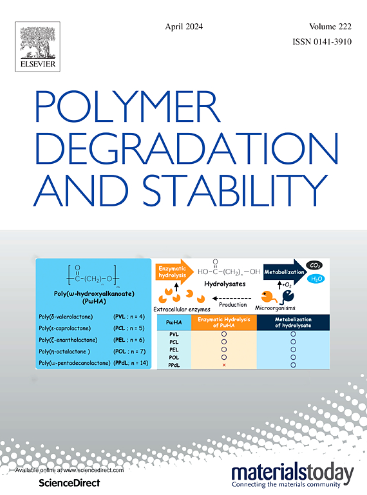Defining the degree of degradation in plastics: Quantification of accumulated degradation products and leached stabilizers for predicting end-of-life
IF 6.3
2区 化学
Q1 POLYMER SCIENCE
引用次数: 0
Abstract
Plastics degrade through various mechanisms, complicating the comprehensive chemical definition of degradation. As the accumulation of degraded products leads to sudden declines in material properties and triggers microplastic dispersion, a chemical degradation metric is essential for predicting plastics’ end-of-life. Here, we propose defining degradation by the weight ratio of “completely degraded polymer (CDP)” to pristine polymer, determined via pyrolysis mass spectrometry (MS). By simplifying the complex degradation evaluation into a straightforward framework of compositional analysis, a comprehensive degradation metric can be obtained without tracking individual degradation pathways. Moreover, by including stabilizers as system components, stabilizer leaching and polymer degradation can be concurrently visualized in the same framework. We demonstrate this approach in polyurethane films subjected to accelerated degradation tests and, by correlating the CDP-defined degradation metric with mechanical property evaluations, successfully identify the threshold degradation level that marks a material's end-of-life. Furthermore, this method reveals deeper insights into degradation mechanisms: stabilizer leaching and polymer degradation are complementary processes that induce each other. This comprehensive degradation metric will also be crucial for grading recycled materials, promoting the circular economy in plastics.
求助全文
约1分钟内获得全文
求助全文
来源期刊

Polymer Degradation and Stability
化学-高分子科学
CiteScore
10.10
自引率
10.20%
发文量
325
审稿时长
23 days
期刊介绍:
Polymer Degradation and Stability deals with the degradation reactions and their control which are a major preoccupation of practitioners of the many and diverse aspects of modern polymer technology.
Deteriorative reactions occur during processing, when polymers are subjected to heat, oxygen and mechanical stress, and during the useful life of the materials when oxygen and sunlight are the most important degradative agencies. In more specialised applications, degradation may be induced by high energy radiation, ozone, atmospheric pollutants, mechanical stress, biological action, hydrolysis and many other influences. The mechanisms of these reactions and stabilisation processes must be understood if the technology and application of polymers are to continue to advance. The reporting of investigations of this kind is therefore a major function of this journal.
However there are also new developments in polymer technology in which degradation processes find positive applications. For example, photodegradable plastics are now available, the recycling of polymeric products will become increasingly important, degradation and combustion studies are involved in the definition of the fire hazards which are associated with polymeric materials and the microelectronics industry is vitally dependent upon polymer degradation in the manufacture of its circuitry. Polymer properties may also be improved by processes like curing and grafting, the chemistry of which can be closely related to that which causes physical deterioration in other circumstances.
 求助内容:
求助内容: 应助结果提醒方式:
应助结果提醒方式:


